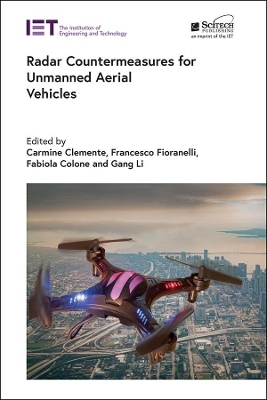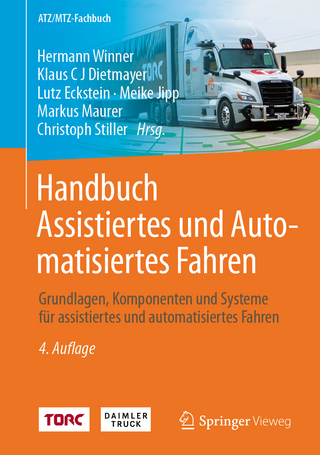
Radar Countermeasures for Unmanned Aerial Vehicles
Institution of Engineering and Technology (Verlag)
978-1-83953-190-3 (ISBN)
Over the last ten years, the numbers of unmanned air vehicles (UAVs) or “drones” have changed from being just a few specialist systems, used for scientific data gathering and military purposes, to them proliferating in huge numbers. They are used across a broad range of different leisure, commercial and military activities. UAVs can be used for: movement of items in factories for manufacturing, passenger and freight transportation, can take various roles in the agriculture and forestry industries (dispensing seeds, watering and monitoring crops), remote sensing for the oil and gas industries, traffic flow monitoring, support of emergency services, hobbies, security, military and many other applications.
The expansion in the use of unmanned air vehicles has come about due to the development of low cost, high performance stable platforms, employing equally low-cost communication and navigation systems supplemented by simple to use software and interfaces. Therefore, there is a need to be able to monitor the rapidly changing use of airspace, especially at low and normally neglected altitudes to ensure UAVs do not compromise safety or are used for malicious purposes. Radar is the only sensor able to perform this function on a 24-hour, all weather, wide-area basis.
This book, concerned with radar surveillance of UAVs, has been compiled using contributions from the leading experts around the world to create a single body of knowledge on this important, yet still emerging, topic. It is aimed at advanced students and researchers with an interest in radar systems.
Carmine Clemente is a Reader at the Department of Electronic and Electrical Engineering, University of Strathclyde, the United Kingdom. His research is focussed on sensor signal processing for defence and civilian applications, with a specific interest on radar signal processing. He directs the Sensor Signal Processing & Security Labs at the University of Strathclyde; he is a senior member of IEEE and serves as associate editor for the IEEE Transactions on Aerospace and Electronic Systems and Frontiers in Signal Processing. Dr Clemente has authored over 140 peer-reviewed publications and book chapters. Francesco Fioranelli is an assistant professor in the Microwave Sensing Signals and Systems (MS3) section within the Department of Microelectronics at the Delft University of Technology (TU Delft). His research interests and current projects include distributed radar and automatic target classification working at the interface of machine learning and radar signal processing in automotive and health-care applications, among others. Dr Fioranelli is a senior member of the IEEE and author of over 100 peer-reviewed publications and book chapters. Fabiola Colone is an associate professor at the Department of Information Engineering, Electronics and Telecommunications (DIET) of Sapienza University of Rome, Italy. Dr Colone's research activity is devoted to radar systems and signal processing and, on these topics, she has authored over 150 peer-reviewed publications and book chapters. Dr Colone has been co-recipient of the 2018 Premium Award for Best Paper in IET Radar, Sonar & Navigation. Since 2017 she is a member of the Board of Governors of the IEEE Aerospace and Electronic System Society (AESS) in which she has served as vice president for Member Services. She is a senior member of IEEE from 2017 and a member of the IEEE AESS Radar System Panel from 2019. Dr Colone is an associate editor for the IEEE Transactions on Signal Processing, the Int. Journal of Electronics and Communications (Elsevier) and Frontiers in Signal Processing. Gang Li is a professor in the Department of Electronic Engineering, Tsinghua University, China. His research interests include radar signal processing, remote sensing, distributed signal processing, sparse signal processing and information fusion. He has authored over 160 journal and conference papers. He is the author of Advanced Sparsity-Driven Models and Methods for Radar Applications (London, UK: IET - SciTech Publishing, 2020). He is an associate editor for the IEEE Transactions on Signal Processing and a member of the Sensor Array and Multichannel (SAM) Technical Committee of the IEEE Signal Processing Society. He is the recipient of the National Science Fund for Distinguished Young Scholars of China and the Royal Society-Newton Advanced Fellowship.
Introduction
Chapter 1: Counter UAS systems overview
Chapter 2: Systems design considerations
Chapter 3: Applications of millimetre wave radar for UAV detection and classification
Chapter 4: Detection and tracking of UAVs using an interferometric radar
Chapter 5: Passive radar detection of drones with staring illuminators of opportunity
Chapter 6: DVB-T-based passive radar for silent surveillance of drones
Chapter 7: Multiband passive radar for drones detection and localization
Chapter 8: GNSS-based UAV detection
Chapter 9: Radar UAV and bird signature comparisons with micro-Doppler
Chapter 10: Radar recognition of multiple UAVs
Chapter 11: Advanced classification techniques for drone payloads
Chapter 12: Good practices and approaches for counter UAV system developments - an industrial perspective
Conclusion
| Erscheinungsdatum | 03.11.2021 |
|---|---|
| Reihe/Serie | Radar, Sonar and Navigation |
| Verlagsort | Stevenage |
| Sprache | englisch |
| Maße | 156 x 234 mm |
| Themenwelt | Technik ► Fahrzeugbau / Schiffbau |
| Technik ► Luft- / Raumfahrttechnik | |
| Technik ► Nachrichtentechnik | |
| ISBN-10 | 1-83953-190-8 / 1839531908 |
| ISBN-13 | 978-1-83953-190-3 / 9781839531903 |
| Zustand | Neuware |
| Haben Sie eine Frage zum Produkt? |
aus dem Bereich


